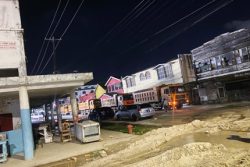Editor’s note: As part of the newspaper’s contribution in the run-up to the November 28 general election, the presidential candidates of the political groupings represented in Parliament have been invited by Guyana Publications Inc to submit weekly columns which will be carried in the Sunday Stabroek. The series began two weeks ago and will end on November 27. The column below was received from the Alliance For Change.
By Dr Tarron Khemraj
Introduction
The PPP’s Manifesto claims it can deliver 25, 000 Information and Communications Technology (ICT) jobs over the next five years. The manifesto presents its ICT plan over three inadequate pages. No specific policies were given. The most specific the manifesto gets is the One Laptop Per Family (OLPF), “actively promoting Guyana as a destination for investments in ICT,” and the laying of fibre optic cables. The AFC certainly agrees that ICT is crucial for economic growth over the long term.
We will go as far and say ICT is more important than gold and oil. It is for this reason that ICT is a crucial aspect of the AFC’s Action Plan (our manifesto). However, we have serious doubts whether the PPP can deliver 25,000 new jobs in this sector over five years.
We see this as an election year gimmick. We see no serious plan or previous track record that will lead us to believe the PPP can bring in the level of investment to achieve these jobs. For example, there were few major foreign investments in new industries in the past twelve years. Here we mean foreign investments in new industries (only Digicel comes to mind) and not investments meant for buying up old assets as in the bauxite industry. Foreign private investments might not be consistent with PPP ideology. Foreign investments from mainly Russia and China are permitted with a small amount from Canada. The OLPF or the laying of fibre optic lines – important as the latter is – cannot achieve this jobs target.
Cleaning
up mal-investments
It is not only the limited investment track record of the PPP that matters, but also they will need to spend heavily over the next few years salvaging and cleaning up the mal-investments that were undertaken in recent years (assuming of course Mr Ramotar wins). These mal-investments, sub-optimal or bad investments will exert a tremendous cost to fix. This is money that will be taken away from the ICT policy of the PPP.
They cannot achieve both spectacular ICT growth and fix the bad investments. This is a consequence of inefficiency and bad decisions. The citizens suffer when the government makes bad investments. I hope the citizens will rise up in anger and punish the mad decision-makers at the upcoming election.
The first mal-investment is the Skeldon sugar factory. Even the PPP’s Manifesto acknowledges that this has been a bad decision. As a matter of fact, Guyanese ought to be angry because it will take millions of US$ to fix the sugar factory that should have been done properly the first time. As is well known, the PPP invested US$200 million in a sugar factory, which has one favourable aspect – the bagasse electricity component.
However, the thing would just not work to specification. It was well known by the mid-1990s that the subsidized European sugar prices would have to go since they are inconsistent with WTO rules. Therefore, not only did the PPP make the mistake of investing deeply in a sugar factory, they built a flawed and problematic one. Millions of dollars that could have gone into ICT and other sectors will now have to go into fixing the Skeldon sugar factory.
Many infrastructure projects including roads, bridges and wharves are not done well. They are breaking quickly after construction. These have to be rebuilt. There is still a need for a proper four-lane highway to the airport as the extended East Bank road is really not a four-lane road but a wide two lane.
This road is typical of Third Worldism and an ad hoc piece of infrastructure project. They still have to make sure Fip Motilall finishes his US$15.4M road through virgin forest. Of course, the cost of the Amaila Hydroelectricity project is now US$835M. The present demand for electricity is around 190MW. The population can therefore expect a very high electricity price. Furthermore, I have not seen anything credible from the PPP’s Manifesto that tells me they can finish this project and still deliver 25,000 ICT jobs.
AFC’s realistic jobs plan
As noted above the AFC sees ICT as crucial for efficiency gains for the society as a whole. We do not believe given present conditions that there can be 25,000 new ICT jobs in five years.
However, given the AFC’s comprehensive proposals we expect at least 35, 000 jobs to be created from various industries. We also expect to save the Demerara and West Berbice sugar estates as we move into ethanol manufacturing for local consumption through our E10 mandate.
A first line of realistic AFC policies would be the intensification of vocational training. We expect to train around 10,000 people in landscaping design (this connects with our national beautification programme), carpentry, masonry, electrical technicians, computer technicians, mechanical technicians, machinists, etc. These are fairly easy programmes to implement in the first stage of our development plan. Some of these good folks will eventually be self-employed and receive funding for small businesses.
A second-line policy would be to bring back about 14,000 Guyanese as part of our diaspora policy. Together with bringing back members of the diaspora, we will bring in large-scale foreign investments which will employ Guyanese and those returning. We anticipate more people returning but we will target about 14,000 individuals either working or setting up new businesses. This is very realistic and doable. Our ethanol mandate – E10 – will create around 2000 new manufacturing jobs.
It will save many thousands. Our Region 10 industrial policy will create around 7,000 new employments there. Our financial sector modernization plan will generate around 1,000 new jobs. The focus and Arts and Culture industries can create another 1,500 openings.
This level of job creation will have a significant positive impact on the amount of tax revenues the AFC government will raise.
This will help to balance the fiscal budget after the AFC cuts the VAT and increases salaries in the first two years. Contributions to NIS will also increase thus helping to stabilize the fund. This level of job stimulation will have a significant favourable effect on the entire society.
Existing small mom and pop businesses will see a significant boost in demand for the goods and services they sell. Existing farmers will have to plant more and not worry about demand as is the case with Minister Persaud’s ‘Grow More Campaign.’
The AFC has the superior and realistic policy proposals for Guyana.








